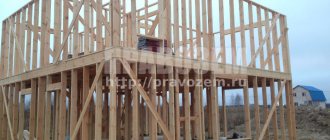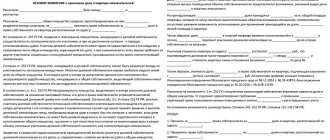Why do you need to register ownership of a house?
New homeowners are divided into “three streams”:
- The first to buy ready-made houses within municipalities
- The latter build them on plots specially allocated for individual housing construction
- Still others are building on the land of garden/dacha partnerships
The motives for registration differ among all groups, as do the necessary documents for registering ownership of a house. Let's dwell on the motives for now:
- A house that is not registered and not registered does not legally exist. Therefore, the owner has no legal rights to it - what rights can there be to non-existent property? Over time, a house built without the appropriate approvals and unregistered will be recognized as “self-construction”, and its owner will be fined.
- The allocated plots of individual housing construction are intended for the construction of residential buildings. If “legal” houses do not appear on them for several years, the tax on such land increases significantly.
- Country cottages in gardening partnerships were in a “suspended” state for a long time - the legislation did not give clear answers to the question of how to legitimize their ownership. Finally, Federal Law No. 171 of 2014 appeared, which was immediately popularly called the “dacha amnesty.” It is necessary to take advantage of the simplified procedure for registering these buildings, and urgently. Because the “dacha amnesty” (the period of which has already been extended several times) will end sooner or later, and it is no longer possible to carry out transactions with unregistered real estate. It's not just about selling. It is even impossible to bequeath/donate it to a relative.
- The DCT transaction cannot be considered closed until the purchased house has been registered as a property. The rights to it, of course, will be established thanks to the signed agreement, but will not yet be fully protected.
Why is real estate registration necessary?
In fact, an existing building is not a legal object until it is entered into the unified state register - the Unified State Register. Real estate can be called unauthorized construction, that is, from the point of view of the law, construction is contrary to the rules. For the owner, this means that he does not have the legal ability to dispose of his right to property in any way. That is, you can live inside, carry out communications, pay for utilities, etc. But you will not be able to officially rent out your home, mortgage it to a bank, sell or exchange it, include it in a will or draw up a deed of gift.
Tasks for decorating a house after construction
This procedure is in the interests of both parties – the state and the copyright holder. The main consequences and opportunities that registration opens up:
- Property tax can only be calculated if the property is registered in the register and has a cadastral passport.
- Protection of real estate rights by government services. The property actually belongs to you when it is registered. Therefore, if robbers penetrate the squatter building, it will be much more difficult to defend their case.
- Compensation in monetary terms in a number of cases, including when housing was completely or partially destroyed during fires, natural disasters and other emergencies.
- The ability to sell, rent, donate or bequeath a residential house as an inheritance.
- Determination of cadastral value - it is required for a real assessment of the material significance of the building.
Real estate must have an official owner, so you should not ignore the registration of a newly built private house.
Registration of home ownership: instructions
The easiest way is to register a ready-made house, already registered in the cadastral register, purchased from the previous owner. You must submit an application to Rosreestr, accompanied by title documents and a receipt confirming payment of the fee.
If you need to register a building for the first time, the step-by-step instructions for registering ownership of a house will be somewhat more complicated. But the “dacha amnesty” is still in effect, so a simplified procedure is available. It includes:
- Calling a cadastral engineer who will survey the site and draw up a cadastral plan of the house (cadastral registration is regulated by Federal Law No. 221)
- Registration of a building permit (more recently it has been replaced by a notice of construction)
- Obtaining a technical passport for your home
- Assigning a postal address
- If you need registration, you need to resolve the issue with the local administration
Then the step-by-step registration of ownership of the house is no different from registering other real estate. You need to contact the MFC with a package of documents, or submit them to Rosreestr electronically, through the State Services portal.
What has changed in legislation
In 2006, Federal Law No. 93 on a simplified registration scheme for private houses came into force. In 2021, the regulatory legal act underwent changes that simplified the procedure for registering ownership of a dacha building.
A basic registration system has been introduced that eliminates illegal actions with real estate. Only the owner of the building can obtain registration information by presenting a title document to Rosreestr. A unified database of real estate allows owners to resolve issues regarding the design of a building at their place of residence. There is no need to go to the region where the property is registered.
List of documents for registering ownership of a house
A minimum document agreement will be needed if you are simply planning to change the owner of a house already registered with Rosrestr. It includes:
- An application drawn up in a strict form. Samples can be found here, but there is no need to prepare anything in advance. At the MFC, the registrar will fill out the form himself, and when working with the State Services website, the form will appear on the screen.
- Owner's civil passport
- Title documents for the house and the plot on which it stands
- Duty receipt
If the procedure for registering ownership of a house involves preliminary cadastral registration, you will also need:
- Cadastral passports of the house and land plot
- Technical plan of the house
- Declaration for all buildings located on the site in addition to the house
- Consent documents signed by the local administration
What should you pay attention to when building a house?
When building a house, it is necessary to comply with urban planning regulations. But where can I look at these urban planning standards?
You are building a house on a certain plot of land, which falls within a certain urban planning zone (a zone for the development of individual residential buildings, a zone for gardening, market gardening or another zone). For each locality (municipal entity), Land Use and Development Rules have been approved, which can be freely viewed by anyone on the website of the Administration of the corresponding locality (municipal entity).
You need to open the Land Use and Development Rules and find the “urban planning regulations” section there. All regulations for all zones are described there. Development rules are described for each permitted use of land.
You can also order an urban planning plan for a land plot from a local government authority (or from the MFC). This document will contain all the necessary information regarding the possibility of developing this site (urban planning zone, setbacks, etc.).
State duty for registration of ownership of a house
The fee is similar to that paid for registering an apartment - 2000 rubles. It must be paid before submitting documents. At the MFC this can be done right on the spot.
If the house is registered as joint ownership by shares, the fee should be divided among all owners in the same proportions as the shares.
Registering a house as the property of spouses does not require the allocation of shares. Regardless of who is listed as the owner, the house will be considered shared. Therefore, the fee can be paid entirely by the homeowner spouse.
Sometimes the guardianship service requires the allocation of shares to minor children. The fee can also be paid in full by the parent in whose name the house is registered, since he is the legal representative of minor citizens.
The procedure for registering ownership of a house with a mortgage
Since a mortgage is taken out for the purchase of finished houses, the scheme is not much different from obtaining a mortgage loan for an apartment. There are only two significant differences:
- The package of necessary documents includes an additional title document for the land
- The interest rate of loans is slightly higher than for residential mortgages. Banks explain this by the lower liquidity of private houses compared to apartments and the increased risk of damage to wooden buildings (for example, from fire).
The rest of the agreement is standard, as is the registration procedure. EGRN enters the encumbrance of the house into the register until the loan is paid in full
Documents required to register a building
To register buildings on a land plot, you must collect the following package of documents:
- to write an application;
- provide a passport and a copy of the applicant’s passport;
- certificate of ownership of the land plot or on what grounds the citizen owns or uses it;
- technical and cadastral passport of the site;
- receipt for payment of state duty;
- building permit.
Deadline for registering ownership of a house
If we are talking only about registering ownership of real estate, the usual period is:
- 7 working days after submitting the application (plus 2-3 days if the application is made through the MFC)
- 1 working day when transmitting documents electronically on the State Services portal
If you first need to register the house/plot with cadastral registration, the procedure will take more time. It usually takes about a month.
Registration of ownership of a house is not so much complicated as it is troublesome. Often homeowners prefer to use the help of lawyers. It is enough to write a power of attorney, pay for the service (it will cost approximately 5-10 thousand rubles - depending on the complexity of the process), and after a while receive a ready-made registration.
But you can also save money by registering yourself, using legal advice on the prav.io portal. Initial consultations are free. The cost of more detailed and specific ones is only a few hundred rubles.
Is it possible to register unfinished construction?
Building a house is a difficult and costly task. It happens that a person started construction, but did not complete it. A citizen is faced with the question of how to register unfinished construction, whether it is possible to register a house and where to go. The article provides answers to common questions about unfinished construction, as well as how you can register unfinished construction using a simplified scheme.
The law provides a clear definition of what constitutes unfinished construction of a residential building. We are talking about a building that has not been put into operation. In this situation, it does not matter at what stage the construction stopped, whether the house is half finished, or the owner has just started construction. The construction of a house can be interrupted at any stage and for various reasons.
Registration of unfinished construction of a private house is extremely important; it allows you to sell the unfinished building, donate it or make other transactions with it.
It is possible to register an unfinished project, but the procedure has its own characteristics. An unfinished object is tied to a plot of land on which construction is taking place. Since the work is not completed, the house cannot be used as a living space, it is not suitable for living. The owner cannot obtain permission to put the building into operation.
- The object is of a capital nature, not temporary. That is, the construction of a building takes place on a foundation. This allows you to exclude kiosks and stalls from the list of unfinished objects;
- The house did not acquire a formal appearance during construction; work is underway at the site. In this case, it does not matter whether we are talking about the stage of arranging the foundation, walls or final finishing.
From all of the above, we can conclude that an unfinished house is a building whose installation and finishing have not been completed, but the house has a foundation. Legislators and lawyers note that it is the foundation that indicates that the constructed structure cannot be moved, so we are talking about a real estate object.
Until recently, such objects could not be owned; the authorities did not issue permission for registration. Amendments to the Civil Code of the Russian Federation have changed the situation. Now a citizen can register unfinished construction.






